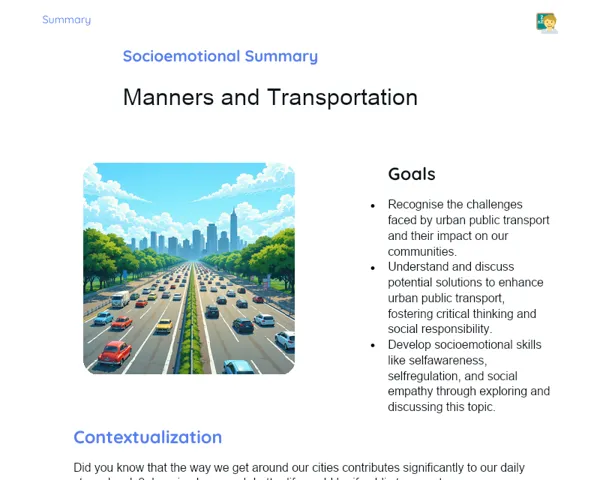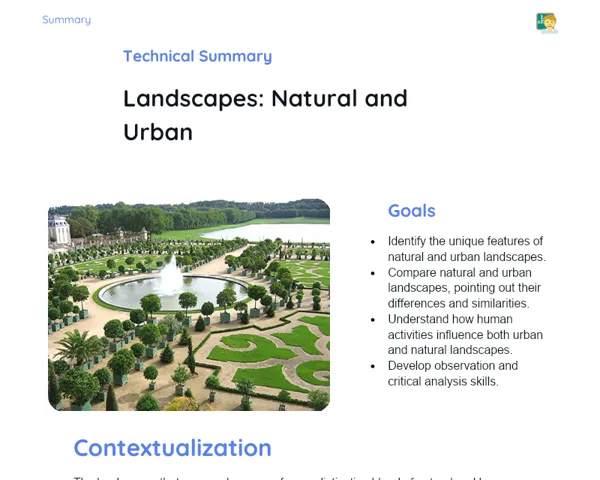Summary Tradisional | Weather Elements
Contextualization
Climate is a key factor that shapes the living conditions in various parts of the world. It refers to the average atmospheric conditions of a region over an extended period, typically decades. Unlike weather, which captures the atmospheric conditions at a specific moment, climate encompasses patterns of temperature, humidity, rainfall, atmospheric pressure, and wind that recur in a predictable pattern. Grasping these elements is crucial for understanding how climates form and how they influence our daily lives and the environment.
The elements of climate consist of temperature, humidity, precipitation, atmospheric pressure, and winds. Temperature is affected by solar radiation and the tilt of the Earth, while humidity pertains to the amount of water vapor in the air, which impacts cloud formation and rainfall. Atmospheric pressure directly affects weather conditions, with high-pressure areas usually linked to clear skies and stable conditions, whereas low-pressure areas are often associated with overcast and rainy weather. Winds arise from differences in pressure and temperature and can be categorised into various types, such as trade winds and westerlies, shaping global climate patterns. Additionally, events like cold fronts, storms, and hurricanes are pivotal to climate dynamics, significantly impacting both the environment and society.
To Remember!
Temperature
Temperature is a fundamental element of climate, indicating the measure of heat in a specific area. The primary source of energy that warms the Earth is solar radiation. The tilt of the Earth's axis and its rotation affects the distribution of this energy, leading to temperature variations across the year and between different regions. Generally, areas near the equator tend to be warmer, while those close to the poles are cooler.
Temperature directly influences how we perceive heat and the patterns of rainfall. Warm air is lighter and can hold more moisture, facilitating cloud and precipitation formation. On the other hand, cold air is denser and is commonly associated with low-humidity conditions.
Additionally, temperature determines the various climate types around the globe, such as tropical, temperate, and polar climates. Changes in global temperature, driven by global warming, can profoundly impact climate patterns, affecting both ecosystems and human societies.
-
Solar radiation is the primary source of energy that warms the Earth.
-
The tilt of the Earth's axis and the rotation of the planet influence the distribution of temperature.
-
Temperature affects cloud formation and precipitation.
Humidity
Humidity refers to the amount of water vapor in the air and is vital for cloud and rainfall formation. Absolute humidity measures the total water vapor in the air, while relative humidity compares the actual water vapor content to the maximum amount the air can hold at a given temperature.
Relative humidity significantly impacts our thermal comfort. In high humidity conditions, sweat evaporation is less efficient, heightening the sensation of heat. Conversely, in low humidity, evaporation occurs more rapidly, making us feel colder.
Humidity is also essential in creating climatic phenomena, such as fog and frost. Regions with high humidity often experience higher rainfall, directly affecting vegetation and water resource availability.
-
Absolute humidity measures the total amount of water vapor in the air.
-
Relative humidity is the percentage of water vapor relative to the maximum amount the air can hold at a specific temperature.
-
High humidity increases the perception of heat, while low humidity intensifies the feeling of cold.
Precipitation
Precipitation includes all forms of water that fall from the atmosphere to the Earth's surface, such as rain, snow, hail, and dew. Precipitation is a crucial component of climate because it replenishes water in rivers, lakes, and aquifers.
The process of precipitation usually involves the condensation of water vapor in clouds, followed by the merging of water droplets until they are heavy enough to fall. The distribution of precipitation varies greatly worldwide and is influenced by factors such as geography, proximity to water bodies, and atmospheric currents.
Different types of precipitation have varying effects. For instance, rain is essential for agriculture, while snow can disrupt transportation and economic activities in colder regions. Irregular precipitation can lead to situations like droughts or floods, which have significant repercussions for the environment and communities.
-
Precipitation includes rain, snow, hail, and dew.
-
The formation of precipitation involves the condensation of water vapor in clouds.
-
The distribution of precipitation is influenced by geographical features, water bodies, and atmospheric currents.
Atmospheric Pressure
Atmospheric pressure is the force exerted by the weight of air pressing down on the Earth's surface. It fluctuates with altitude and temperature, decreasing as altitude increases and varying according to air temperature. High-pressure areas usually correlate with clear and stable weather, whereas low-pressure areas are often linked to cloudy and rainy conditions.
The differential pressure between two regions creates winds, moving air from high-pressure to low-pressure areas. These winds are instrumental in redistributing heat and moisture globally, thereby influencing climate patterns.
Understanding atmospheric pressure is essential for weather forecasting and grasping climatic phenomena such as fronts and cyclones. For example, a sharp drop in atmospheric pressure can signal an approaching storm, which allows for timely preventive action.
-
Atmospheric pressure is the force exerted by the weight of the air on the Earth's surface.
-
High-pressure areas are associated with clear and stable weather, while low-pressure areas are linked to cloudy and rainy conditions.
-
The pressure differences between regions generate winds, influencing climate patterns.
Key Terms
-
Climate: The average atmospheric conditions of a region over a long period.
-
Weather: The atmospheric conditions at a specific moment.
-
Temperature: A measure of heat in a region, influenced by solar radiation and the tilt of the Earth.
-
Humidity: The amount of water vapor in the air, affecting cloud and precipitation formation.
-
Precipitation: Various forms of water that fall from the atmosphere to the Earth's surface, including rain, snow, and hail.
-
Atmospheric Pressure: The force exerted by the weight of air on the Earth's surface, influencing climate and weather.
-
Winds: Movements of air generated by differences in pressure and temperature, influencing climate patterns.
-
Climate Fronts: Boundaries between air masses with differing temperatures and humidity, which can be either cold or warm.
-
Storms: Severe climatic events characterised by strong winds, heavy rain, and sometimes lightning.
-
Hurricanes: Tropical cyclones with intense winds and heavy rainfall, causing significant environmental and social impacts.
Important Conclusions
In this lesson, we delved into the fundamental elements of climate, specifically temperature, humidity, precipitation, atmospheric pressure, and winds. We learned how each component influences the climate of a region and discussed specific climatic phenomena such as cold fronts, storms, and hurricanes. These elements are vital for comprehending climate variations and their implications for the environment and society.
Studying climate is essential as it directly impacts our daily lives, from agricultural practices to managing natural disasters. A solid understanding of climatic elements is imperative for accurate weather forecasting and for preparing for and adapting to climate change, which poses significant consequences for our environment and communities.
We encourage students to keep exploring this topic, as an awareness of climate is fundamental in addressing future environmental challenges. Diving deeper into this subject can foster greater consciousness of sustainability and the importance of practices that mitigate the effects of climate change.
Study Tips
-
Review the core concepts of each climate element, focusing on definitions and practical examples discussed in class.
-
Utilise climate maps and graphs of temperature and precipitation to visualise variations across different regions globally.
-
Stay updated with articles and news on current climatic events, like cold fronts and hurricanes, to better grasp their causes and impacts within a global context.



